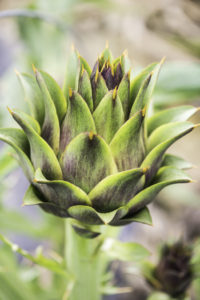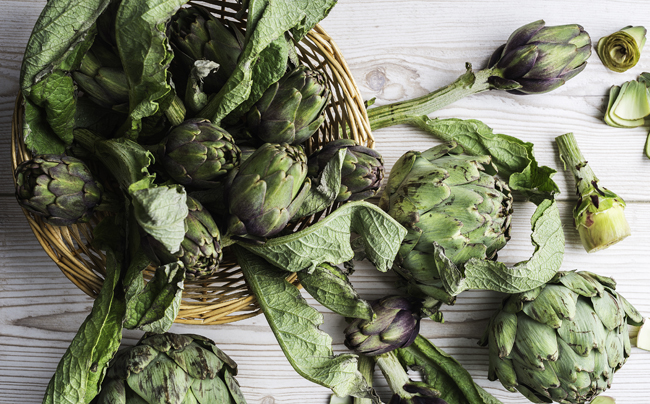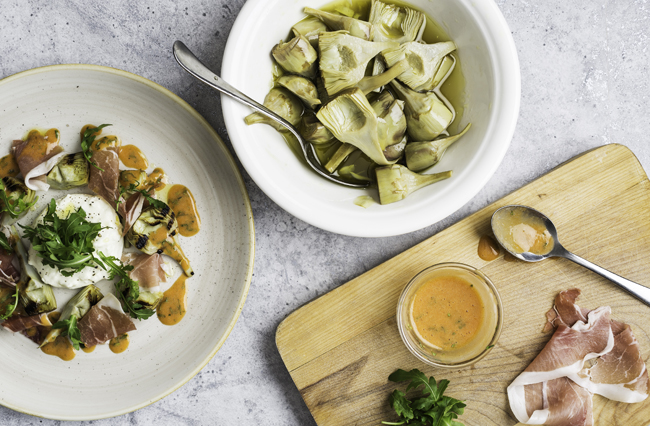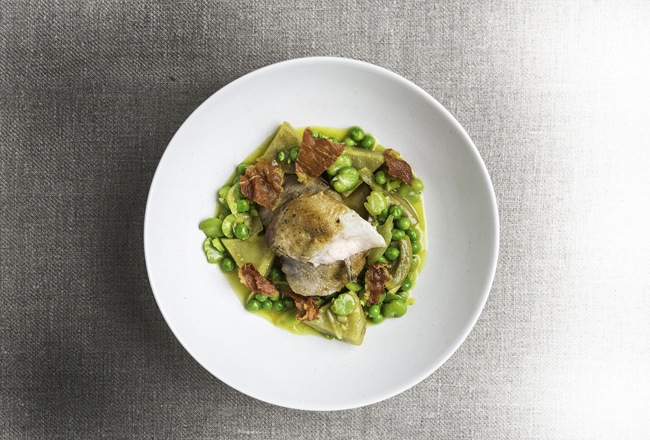Home-grown harvest: Artichokes
Tricky to prepare, artichokes provide chefs with the opportunity to impress customers. Russell Brown reports
‘Farms find market for exotic veg'. That was a headline in The Independent in 1993. In fact, the thrust of the article was about British farmers selling vegetables and salads to other European countries, but it was the ‘exotic' that caught my eye. So much that was once classed as exotic is now much more commonplace.
I'm not sure, however, that globe and baby artichokes are any less exotic now in the eyes of the wider public. A good general indicator of a food's popularity is whether it is widely stocked by the major supermarkets; globe artichokes are pretty hard to get and Waitrose was the only major player I could see listing them. Of course, the situation is completely different both on the continent and for tinned or jarred artichokes.
The situation is equally different for chefs who have long had a fondness for the artichoke. Is it because they are difficult and perhaps tedious to prepare that puts the home cook off and leaves this vegetable more in the realms of the professional kitchen?
Artichokes aren't widely cultivated but are a real favourite in kitchen gardens. The bulk of fresh artichokes available in the UK are from Europe, but there are a few commercial growers in the country that include Watts Farm and Holm Select. The latter are organic growers and harvest artichokes from June to September.
There are a number of classic artichoke dishes, such as vinaigrette, barigoule, marinated artichokes and stuffed artichokes, and there are modern uses, too. Very small artichokes can be shaved thinly and served raw, the hearts pickled or deep-fried and it is a vegetable that is well suited to sous-vide cooking.
Artichokes discolour very quickly when cut. When preparing artichokes, the cut surfaces should be immediately rubbed with half a lemon and the vegetable dropped into acidulated water until you are ready to cook. A traditional method to keep them as white as possible is to cook them ‘au blanc', in a cooking liquor made from water, a little flour, lemon juice and some fat or oil. For sous-vide, the prepared artichokes are vacuum-packed with an acidulated liquid: vegetable stock and wine being one option.
Mark Dodson, chef-proprietor at the Michelin-starred Masons Arms in Knowstone, Devon, serves a dish of monkfish and scallops with artichokes, tomato and basil. Dodson also says that during his tenure as head chef at the Waterside Inn in Bray, he was turning three boxes of large globe artichokes a week for the indulgent dish Oeuf Albert (see the Roux's New Classic Cuisine), which combines a braised artichoke bottom with poached egg, smoked salmon, truffle and smoked salmon mousse.
At the Shore in Penzance, Cornwall, chef-proprietor Bruce Rennie grows his own artichokes and favours an artichoke vinaigrette, a barigoule-style preparation, or artichokes stuffed with crab and a gratin topping.
Salad of burrata, chargrilled baby artichokes and prosciutto
Serves 4
For the artichokes 1 lemon
12 baby artichoke halves
50g reduced vegetable stock
20g white wine vinegar
100ml good olive oil
5g Maldon sea salt
For the dressing (makes 15-20 portions) 5g lecithin powder or 1 egg yolk
10g honey
10g Dijon mustard
75ml white wine vinegar
275ml rapeseed oil
100ml tomato passata
Maldon sea salt and fresh black pepper
1tbs chopped fresh basil
To serve 400g burrata
6 slices prosciutto
Handful of small rocket leaves
Half the lemon and squeeze into a large bowl of iced water. Retain the halves for rubbing the cut artichokes. Trim the artichoke stems to around 4cm. Cut the tops off the artichokes about a third of the way down from the tips. Begin to peel off the outer leaves, stopping when you get to the paler yellowish leaves. Peel the outer green layer from the stem and trim the tough parts from the base. Cut the artichoke in half from top to bottom and use the tip of a teaspoon to scoop out the choke if it is large. On very small artichokes the choke is soft and edible. Drop immediately into the acidulated water.
Once all the artichokes are prepared, mix the remaining ingredients in a bowl, drain the artichokes and toss with the cooking liquid.
Transfer to cooking-quality vacuum bags and seal on full vacuum. Steam or cook in a water bath at 85°C for approximately one and a half hours. Chill in an ice bath or blast chiller if not using immediately.
For the dressing, blend the lecithin, honey, mustard and vinegar together, along with some seasoning. Gradually blend in the oil and finally the tomato passata. Check the seasoning and adjust the acidity if necessary. Add the basil as the dressing is used.
To serve, drain the burrata and allow to come to room temperature. Drain the artichokes and chargrill on the cut surface. Halve lengthwise to serve.
Place the burrata in the centre of shallow bowls or plates and scatter the artichoke pieces around. Tear the ham into bite-sized pieces and add to the plate. Mix the basil into the dressing and spoon it around. Season the burrata with sea salt and freshly ground black pepper and drizzle with good olive oil. Scatter the rocket around the plate.
Roast quail with saffron artichoke heart and summer vegetable ragoût
Serves 4
For the artichoke broth 1 lemon
4 large globe artichokes
100ml good olive oil
2 shallots, peeled and cut into six wedges
2 cloves garlic
100ml white wine
200ml vegetable stock
A pinch of saffron
Cornflour, to thicken
70g blanched peas, prepared weight
70g blanched double-podded broad beans, prepared weight
1tbs chopped chives
Maldon sea salt and fresh black pepper
For the quail 4 x whole quail, wishbone removed, wings trimmed and legs tied together
50ml olive oil
4 cloves garlic
4 sprigs thyme
25g butter
To serve 20-25 small pieces crispy prosciutto
Start by preparing the artichokes. Halve the lemon and squeeze into a bowl of iced water. Retain the halves for rubbing the artichokes as you prepare them. Snap the stems from the artichokes and cut the leaves off two-thirds of the way down from the top. Begin to trim around the artichoke until the tough outer leaves are removed. Trim away the tough outer layer from the bottom and then trim the leaves down to reveal the choke. Scrape out the choke with a dessert spoon. You should be left with a compact disc. Cut the artichoke heart into six wedges and drop into the acidulated water.
Heat the olive oil in a sauté pan, drain the artichokes and dry them. Add to the pan and season well. Cook for two to three minutes and then add the shallots and garlic. Cook until the shallots have begun to soften, stirring frequently, then add the wine and reduce.
Add the stock and saffron and cook at a gentle simmer until the artichoke is completely tender. Slake a little cornflour in cold water and thicken the broth to a very light coating consistency. Add the peas and beans to warm through at the last minute. Adjust the seasoning and add a little lemon juice if required. Finish with the chives.
For the quail, heat half the olive oil and seal the quail until golden brown all over. Add the garlic, thyme, remaining oil and the butter. Baste well and roast in a hot oven for four to six minutes.
Allow the quail to rest breast side down on a rack for five minutes before carving.
To serve, carve the legs and breasts from the quail and place in the centre of shallow bowls. Spoon the artichoke ragoût around and add the crispy ham.
Buying and storage
• The stems on baby artichokes should be stiff
• The head of a globe artichoke should have a little give to it, but shouldn't be opening
• Artichokes will keep refrigerated for around seven days
• If freshly picked, cooking times are likely to be shorter.
Market report
We are in the French season of globe and baby artichokes at the moment and usually the quality of the French choke is superb. This year, however, has been a real struggle for the growers because of the hot weather they have had over a long period of time. The sun is actually burning the heads of the artichokes that are growing in the fields, which has meant a lot have been thrown away. This has bumped up the prices into the markets and shops as there isn't as much available.
Customers buying from the market will probably be paying around £2 per head for a globe artichoke, whereas this time last year they were paying around £1. Baby artichoke is even harder to find and will be a lot more expensive (around £5.90 a bunch). The situation with British-grown artichokes is likely to be similar.
Ashley Clemence www.totalproducelocal.co.uk
Coming soon
Over the next few months I will be featuring fennel and red cabbage in Home-grown Harvest. Do let me know how you use these products on your menus and what your seasonal favourites are.
Email recipes, dish suggestions and photographs to russell@creativeaboutcuisine.com
Continue reading
You need to be a premium member to view this. Subscribe from just 99p per week.
Already subscribed? Log In









